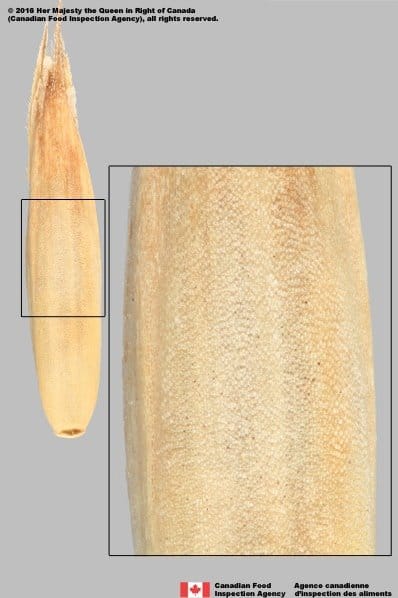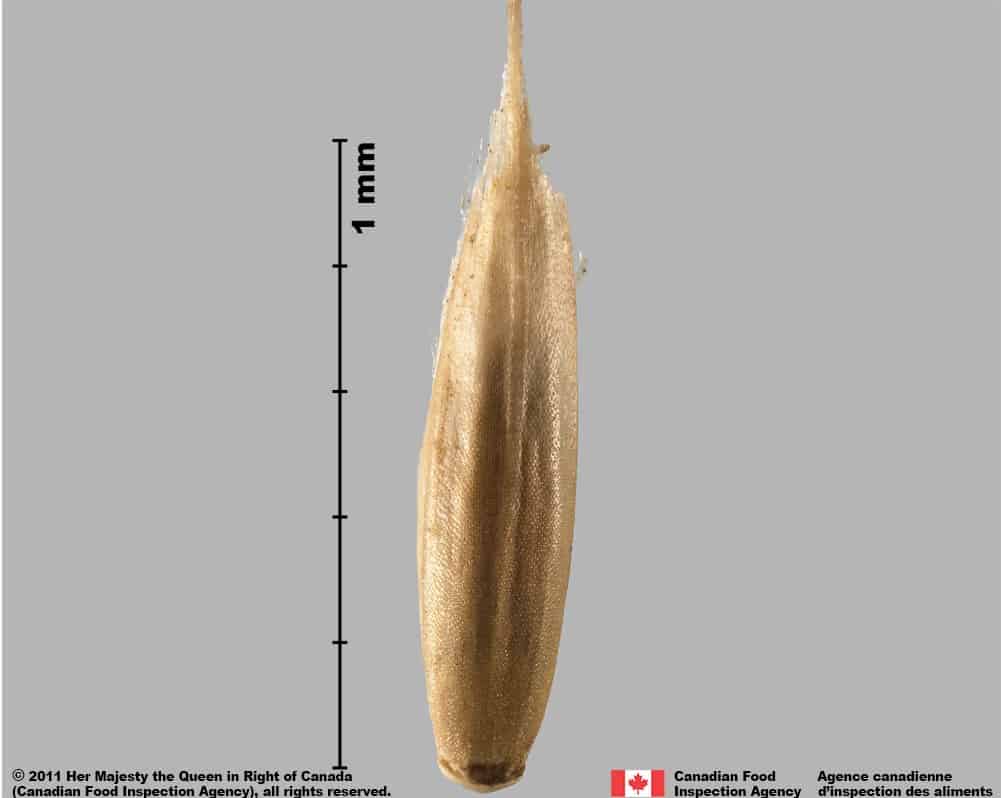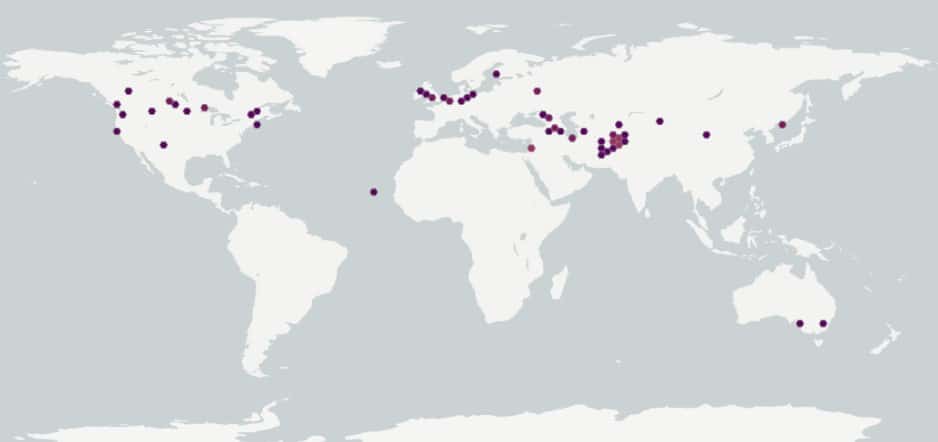Lolium persicum
Overview
Aperçu
Regulation :
Remarques Réglementation:
- CFIA Weed Seeds Order - Class 3: Secondary Noxious Weed Seeds
Regulation Notes:
Distribution :
Répartition :
Native to temperate Asia and southern tropical Asia (USDA-ARS 2021). In the United States, it is widespread in Montana, North Dakota and Wyoming (Barkworth et al. 2007). In Canada, L. persicum occurs in Alberta, British Columbia, Manitoba, Ontario, Quebec and Saskatchewan (Brouillet et al. 2010+).
Habitat and Crop Association :
Habitat et Cultures Associées :
Cultivated fields (especially spring cereals), gardens, railway lines, roadsides and disturbed areas (Darbyshire 2003; Holman et al. 2004).
Economic Use, cultivation area, and Weed Association :
Utilisation économique, zone de culture et association de mauvaises herbes :
Duration of Life Cycle :
Durée du cycle vital:
Annual
Dispersal Unit Type :
Type d’unité de dispersion :
Floret
General Information
RENSEIGNEMENTS GÉNÉRAUX
Lolium persicum was commonly misidentified as L. temulentum, L. rigidum and L. multiflorum when it was first collected in North Dakota in the early 1900’s (Dore 1950). Since then, it has spread throughout Triticum aestivum subsp. aestivum (wheat) growing areas in Canada and the United States in commercial seed and feed grain (Dore 1950).
.Identification
Identification
-
Spikelet
Size
- Spikelet length: 9.0 – 27.0 mm long; 1.5 – 7.0 mm wide (Barkworth et al. 2007)
Shape
- Spikelet is wedge-shaped
Surface Texture
- Spikelet surface is granular textured
Colour
- Spikelet is shiny straw yellow
Other Features
- Spikelet has 4-9 florets (Barkworth et al. 2007)
-
Floret
Size
- Floret length*: 7.9 – 11.2 mm; width: 1.8 – 2.4 mm
*Note: minimum and maximum of 10 florets in a normal range of this species using image measurement (ISMA 2020)
Shape
- Floret is oblong shaped, compressed in 3 dimensions
Surface Texture
- Floret surface is granular textured
Colour
- Floret is shiny straw-yellow
Other Features
Lemma awn
- Awn length: 8.0 -18.0 mm (Barkworth et al. 2007)
- Awns often broken or removed during processing
Callus and Rachilla
- Rachilla is straight-sided, flat, and generally held close to the palea
Other Features
- Palea edge with numerous thin, short teeth

Persian darnel (Lolium persicum) florets







-
Caryopsis
Size
- Caryopsis length: 4.8 – 7.0 mm; width: 1.2 – 2.0 mm (Barkworth et al. 2007)
Shape
- Caryopsis oblong shaped with a groove on the side with the hilum
Surface Texture
- Caryopsis surface is wrinkled with ridged grid reticulation visible under high magnification
Colour
- Caryopsis is reddish brown, can have purple patches
Other Features
- Caryopsis has a long, linear, black hilum in a groove on the side of the caryopsis opposite the embryo
-
Embryo
Size
- Embryo is a rudimentary size compared to the caryopsis
Shape
- Embryo is oval shaped, lateral position at one end of the caryopsis
Endosperm
- Endosperm is hard and white coloured
Other Features
- The hilum is a black coloured line, situated in a groove on the opposite side of the embryo
Identification Tips
CONSEILS POUR L’IDENTIFICATION
The oblong shape, straw yellow colour, granular texture and flat rachillas of Lolium persicum florets look similar to L. multiflorum and L. perenne, but L. persicum florets are larger, with smaller palea teeth and a longer lemma awn compared to other Lolium species.

Persian darnel (Lolium persicum) floret, palea view







Additional Botany Information
AUTRES RENSEIGNEMENTS BOTANIQUES
Similar Species
ESPÈCES SEMBLABLES
Similar species are based on a study of seed morphology of various species, and those with similar dispersal units are identified. The study is limited by physical specimen and literature availability at the time of examination, and possibly impacted by the subjectivity of the authors based on their knowledge and experience. Providing similar species information for seed identification is to make users aware of similarities that could possibly result in misidentification.
Lolium multiflorum Lam. (annual ryegrass )
L. multiflorum florets are smaller (length*: 4.0 – 8.2 mm; width: 1.0 – 2.0 mm, Barkworth et al. 2007), the lemma can be curved away from the palea, and the rachilla can bend away from the palea compared to L. persicum florets with a flat lemma and lemma pressed close to the palea. The palea teeth of L. multiforum are generally larger than L. persicum.
Click to select species
Cliquez pour sélectionner les espèces

Lolium multiflorum
Comparison Window
Fenêtre de comparaison
MAIN SPECIES
ESPÈCES PRINCIPALES
Lolium persicum

Lolium persicum
Poaceae
Persian darnel (Lolium persicum) florets
MAIN SPECIES
ESPÈCES PRINCIPALES
Lolium persicum

Lolium persicum
Poaceae
Persian darnel (Lolium persicum) florets
MAIN SPECIES
ESPÈCES PRINCIPALES
Lolium persicum

Lolium persicum
Poaceae
Persian darnel (Lolium persicum) floret, palea view
MAIN SPECIES
ESPÈCES PRINCIPALES
Lolium persicum

Lolium persicum
Poaceae
Persian darnel (Lolium persicum) floret, lemma view
MAIN SPECIES
ESPÈCES PRINCIPALES
Lolium persicum

Lolium persicum
Poaceae
Persian darnel (Lolium persicum) floret, palea view
MAIN SPECIES
ESPÈCES PRINCIPALES
Lolium persicum

Lolium persicum
Poaceae
Persian darnel (Lolium persicum) floret, lemma view
MAIN SPECIES
ESPÈCES PRINCIPALES
Lolium persicum

Lolium persicum
Poaceae
Persian darnel (Lolium persicum) the granular surface of the floret, lemma view
SIMILAR SPECIES
ESPÈCES SEMBLABLES
Lolium multiflorum

Lolium multiflorum
Poaceae
Annual ryegrass (Lolium multiflorum) florets
SIMILAR SPECIES
ESPÈCES SEMBLABLES
Lolium multiflorum

Lolium multiflorum
Poaceae
Annual ryegrass (Lolium multiflorum) floret, palea view
SIMILAR SPECIES
ESPÈCES SEMBLABLES
Lolium multiflorum

Lolium multiflorum
Poaceae
Annual ryegrass (Lolium multiflorum) floret, lemma view
SIMILAR SPECIES
ESPÈCES SEMBLABLES
Lolium multiflorum

Lolium multiflorum
Poaceae
Annual ryegrass (Lolium multiflorum) florets
Need ID Help?
Besoin d’aide pour l’identification?
Reference(s)
Référence(s)
Barkworth, M. E., Capels, K. M., Long, S., Anderton, L. K. and Piep, M. B., (eds.) 2007. Volume 24. Magnoliophyta: Commelinidae (in part): Poaceae, part 1. Oxford University Press, New York, New York.
Brouillet, L., Coursol, F., Meades, S.J., Favreau, M., Anions, M., Bélisle, P. and Desmet, P. 2010+. VASCAN, the database of vascular plants of Canada. http://data.canadensys.net/vascan/ Accessed April 1, 2021.
Darbyshire, S. J. 2003. Inventory of Canadian Agricultural Weeds. Agriculture and Agri-Food Canada, Research Branch. Ottawa, ON.
Dore, W.G. 1950. Persian darnel in Canada. Scientific Agriculture 30: 157 – 164.
eFloras. 2021. Electronic Floras. Missouri Botanical Garden, St. Louis, MO & Harvard University Herbaria, Cambridge, MA., http://www.efloras.org Accessed April 1, 2021.
Flora of North America (FNA) Editorial Committee, eds. 1993+. Flora of North America North of Mexico [Online]. 22+ vols. New York and Oxford. Accessed December 29, 2022.
Global Biodiversity Information Facility (GBIF) Secretariat. 2022. https://doi.org/10.15468/39omei Accessed via https://www.gbif.org/species/2706225 Accessed December 29, 2022.
Government of Canada (GC). 2016. Canadian Weed Seeds Order. https://laws-lois.justice.gc.ca/eng/regulations/SOR-2016-93/page-2.html (English) https://laws-lois.justice.gc.ca/fra/reglements/DORS-2016-93/page-2.html (French)
Holman, J. D., Bussan, A. J., Maxwell, B. D., Miller, P. R. and Mickelson, J. A. 2004. Spring wheat, canola and sunflower response to Persian darnel (Lolium persicum) interference. Weed Technology 18: 509-520.
International Seed Morphology Association (ISMA). 2020. Method for Seed Size Measurement. Version 1.0. ISMA Publication Guide.
U.S. Department of Agriculture-Agricultural Research Services (USDA-ARS). 2021. Germplasm Resources Information Network (GRIN), https://npgsweb.ars-grin.gov/gringlobal/taxon/taxonomysimple.aspx Accessed April 1, 2021.




